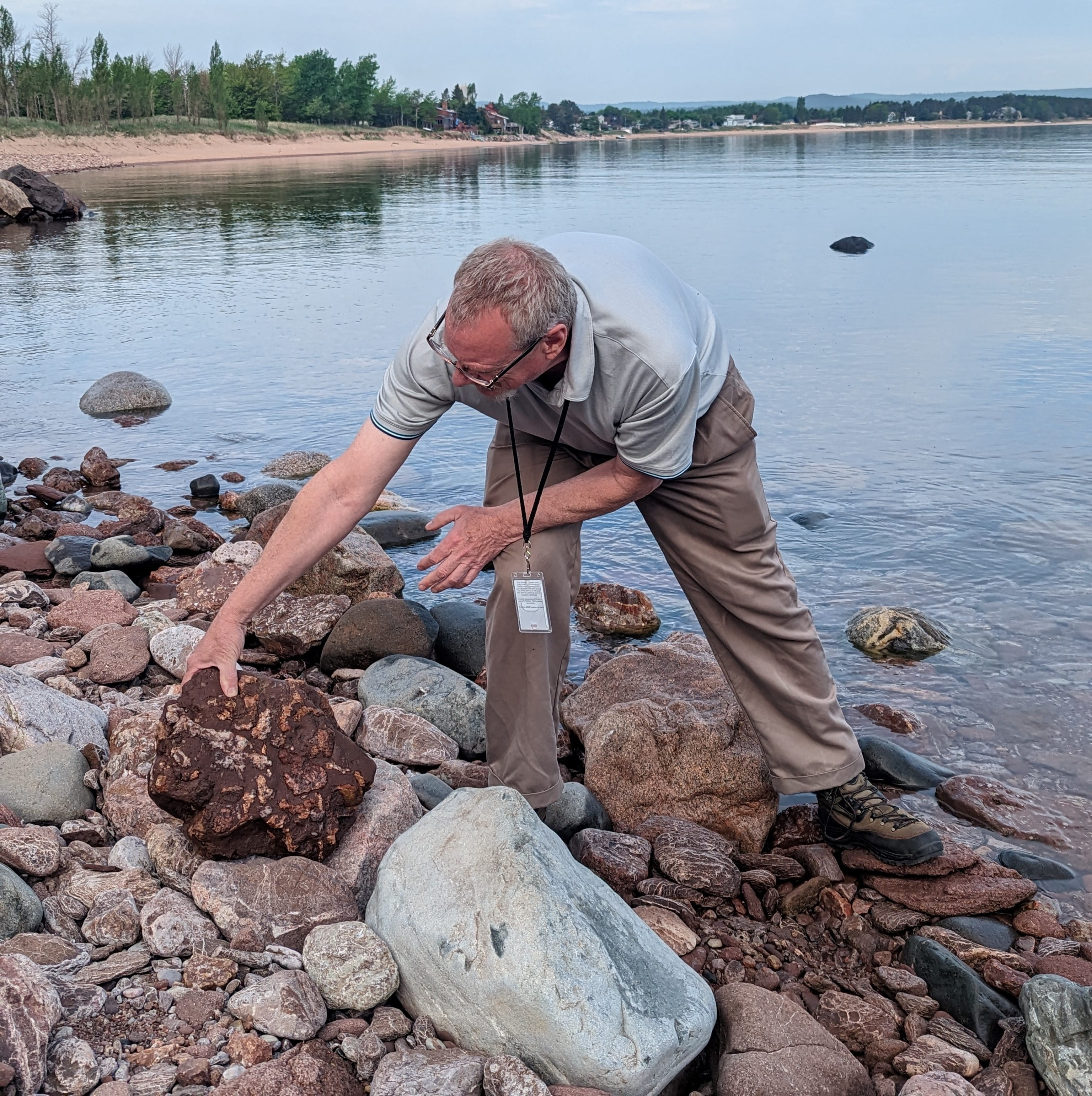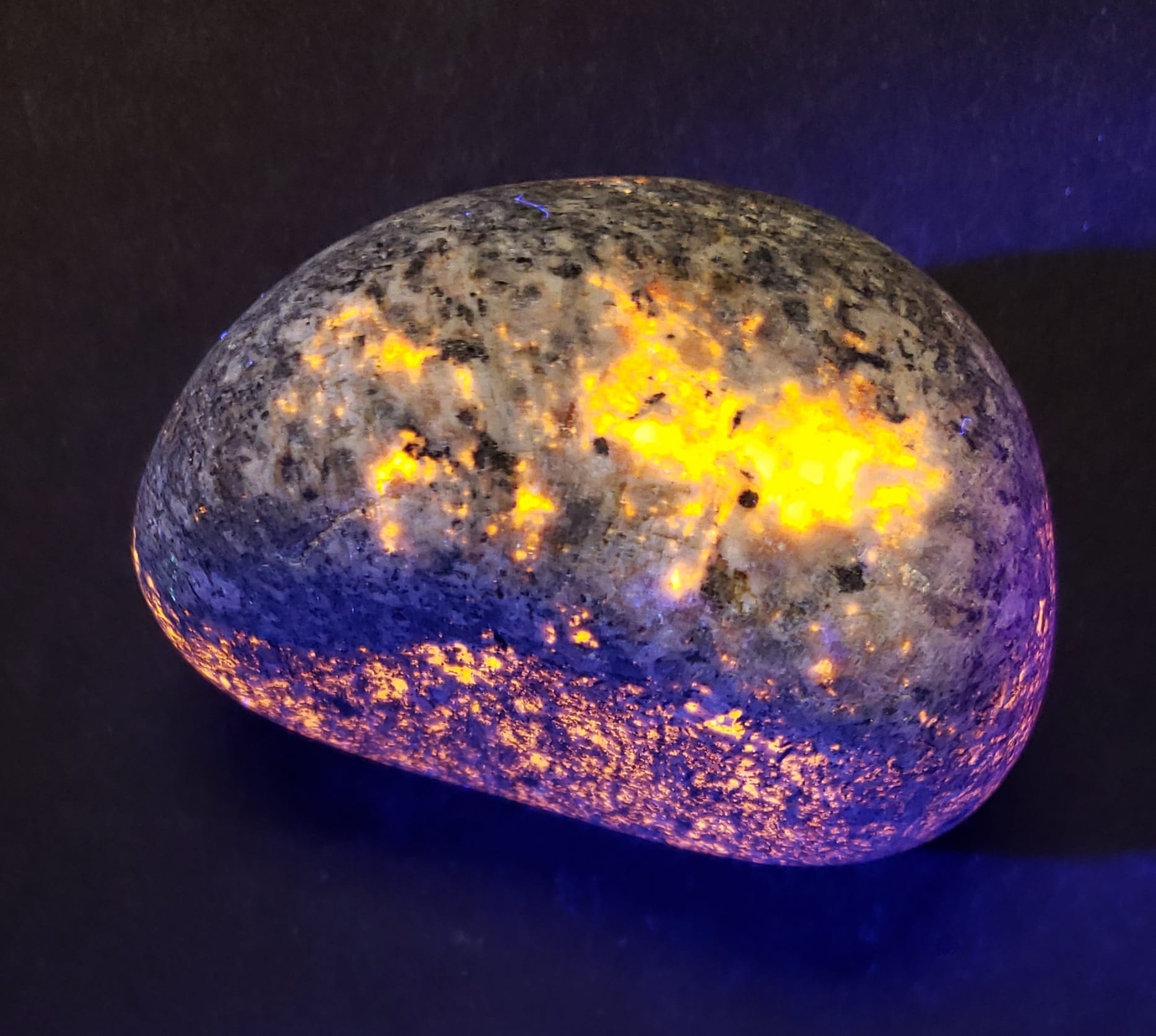The web Browser you are currently using is unsupported, and some features of this site may not work as intended. Please update to a modern browser such as Chrome, Firefox or Edge to experience all features Michigan.gov has to offer.
EGLE rockhound offers tips to find elusive, glowing ‘Yooperlites®’
June 05, 2023
With summer vacation season here, thousands of people will head to Michigan’s Upper Peninsula for some rest and relaxation. For many people, that time will include rock hunting – especially for the elusive Yooperlite®, a fluorescent rock that glows “in the dark” under ultraviolet light. The rock first became known when a U.P. resident discovered them in 2017.
Rob Wolfe, an environmental quality analyst in the Michigan Department of Environment, Great Lakes and Energy’s Marquette District Office, has been a rockhound in Michigan’s Upper Peninsula for 50 years.

Rob Wolfe, of EGLE's Marquette District Office, examines a sedimentary rock along Lake Superior.
In normal light, a Yooperlite® looks like granite. Sodalite replaces quartz, so the larger the mineral size, the brighter the shine, says Wolfe.
There are some five classes of Yooperlites®, Wolfe adds:
- Gemmy (mostly Sodalite or large sodalite crystal, the entire specimen glows orange)
- Snowflake or Flower (similar to snowflake obsidian, large blotches on the surface that look like snowflakes, but crystal glow does not penetrate into the interior)
- Striated (sodalite fills cracks in the rock matrix, so appears as orange lines or veins)
- Spray Paint (tiny crystal droplets scattered around the surface)
- Galaxy (larger crystals than spray paint that are dispersed in the rock that glow like the night sky, crystals penetrate the matrix)

Sodalite syenite (Yooperlite®) on display at the A.E. Seaman Mineral Museum in Houghton, Mich. Courtesy of A. E. Seaman Mineral Museum.
He has found too many Yooperlites® to number and has given most away to promote the rock hunting activity. “The largest was about the size of a baseball, but I would say based on the size of gravel where I search, most are the size of a ‘pinky nail’ to thumbnail length,” Wolfe notes. “I have seen cantaloupe-sized ones found in Houghton County or from divers. There is a limit to how much one can take from public beaches.”
Yooperlites® can be found as loose pebbles and cobbles along many Lake Superior beaches and even in some inland gravel pits, but you won't find large rock outcroppings of them here in Michigan. That's because Yooperlites® are actually from Canada! They are derived from igneous rocks near Marathon, Ontario known as the Coldwell Alkaline Complex and were transported into Michigan by glaciers during periods of continental glaciation.Wolfe offers the following tips to find this mysterious rock in the Upper Peninsula:
- Be respectful of where you search (permission, trash, others searching, etc.). Michigan has rock collecting rules.
- Start with a beach that has known stones, providing you have permission.
- Be willing to share your tips (or specimens) with others as many are first time searchers or haven’t found any yet on previous searches.
- Get a good light (365 wavelength; mine are Convoy brand).
- Wear safety glasses with UV protection ($2 yellow at Harbor Freight), as some people are not courteous when shining lights; be conscious of where your light is shining at all times.
- Go early in the season when cooler temperatures keep most people off the shoreline but go when you have the chance, just don’t expect the beach to be empty.
- It is best to go immediately after a storm as new material is washed up, but not during the storm or high wave action.
- Look not only along the shoreline but out into the water (as far as the light can reach) and at high water mark. Occasionally look behind you as your feet may shift one that was not previously seen.
- Take along a garden tine rake to move the deposited gravel around or to reach out into the water. Yooperlites may not shine on all surfaces, so moving stones around will increase your chance of seeing them if they were not right at the surface or orientation.
- I typically carry two lights (one in each hand) and cross the combined beams using a sweeping side-to-side motion for better coverage and light angle about 6 to 8 feet in front of me.
- With the right light and safety equipment, they will be bright, so you do not need to walk slowly thinking you will miss them. Walk at a normal pace and shine the light with a sweeping motion.
- Again – be respectful of others.
If you are not successful at finding Yooperlites®, you can still see them, as they are now on display at the A.E. Seaman Mineral Museum at Michigan Tech University in Houghton. The museum is open from 9 a.m. to 5 p.m. Monday through Saturday.